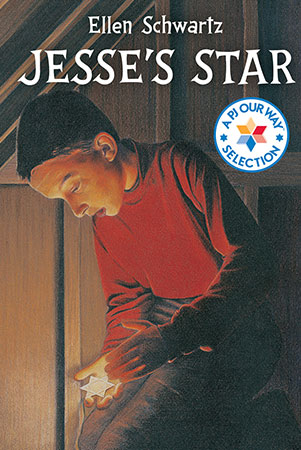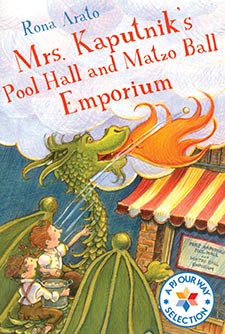Jesse's Star
Yossi dreams of being a hero, but trouble always seems to find him first. When danger strikes, can Yossi save his village? Travel back in time and find out!
Average Rating
( hint: Login to leave a review! )
42 Reviews
Leave Review
What the Book is About
Jewish Content & Values
Positive Role Models
Content Advisory
Talk it Over!
More for You
What the Book is About
Jesse has a deadline for a class project about his ancestors. Poking around his attic for inspiration, he finds a Star of David necklace belonging to Yossi Mendelsohn, his great-great grandfather. Jesse slips on the necklace and immediately becomes Yossi, living in a Russian village called Braslav in the late 18th century.
When Russian soldiers harass the Braslav villagers, Yossi uses his stilts to dress up as the infamous witch, Baba Yaga. Yossi scares the soldiers and saves the day. This act of bravery allows Yossi’s family and the villagers to escape to Canada.
When Russian soldiers harass the Braslav villagers, Yossi uses his stilts to dress up as the infamous witch, Baba Yaga. Yossi scares the soldiers and saves the day. This act of bravery allows Yossi’s family and the villagers to escape to Canada.
Jewish Content & Values
- Jesse’s ticket to time travel is a Magen David (Star of David) that he puts around his neck.
- The Braslav community celebrates Sukkot, a fall harvest holiday.
- Yossi lives in a shtetl (a Jewish village) with a shul (a synagogue) and a rebbe (a religious leader of a Jewish Hasidic sect).
- The rebbe of the Braslavers shows ometz lev (courage of the heart) as he calmly guides the Jewish community despite enforced poverty and the constant threat of violence. Yossi also shows courage in risking his life to save his village.
- The people of Braslav demonstrate hakarat hatov (gratitude) when they give Yossi the Star of David as a token of thanks for saving the village.
Positive Role Models
- Jesse goes from thinking his ancestors are unimportant, to realizing how brave and resourceful they were. Of course, it helps that he has a chance to live as Yossi and experience this bravery first hand.
- Though he is the religious leader of Braslav, the rebbe works humbly with the rest of the villagers to prepare for winter. He stands up to the Russian soldiers and keeps Judaism alive with his positive outlook and determination.
- Jesse’s mom juggles work and home life gracefully. She leaves dinner in the oven and gives Jesse the idea to look in the attic for information on his ancestors before going to her evening meeting.
Content Advisory
While this is an easy book with plenty of positive Jewish content, a few scenes may be mildly scary: The soldiers steal the village’s harvest and then come back and burn their holy books; an anecdote is told about how the Cossacks chopped off Sam of Vladstock’s head and burned his house; and descriptions of the witch Baba Yaga (who is said to live in a house built of bones and who loves to eat small children) might frighten some younger readers.
Talk it Over!
Yossi takes a big risk by using his stilts to scare the soldiers. He isn’t even very adept at using them! Have you ever taken a risk by doing something you thought was important even though you were not sure if you could actually pull it off?
More for You
Central to the celebration of the Jewish holiday of Sukkot is the building of a temporary dwelling called a sukkah. When we think “temporary” our minds go to plastic plates and paper napkins – things we don’t plan on keeping and don’t care too much about. However, the Mishnah (Rabbinic code of law) instructs that when decorating one’s sukkah, one should make the sukkah “one’s permanent abode and one’s house a temporary abode” (Tractate Sukkot 2:9). Does that mean you should forget the cheap plates and plastic chairs, and fill your sukkah with the most beautiful dishes and furniture that you have in your home? The Mishnah suggests that you should! Perhaps this is one way to truly live in the moment. Nothing is ever permanent, but when we live each day with all the beauty we can, our temporality is transcended.
What the Book is About
What the Book is About
Jesse has a deadline for a class project about his ancestors. Poking around his attic for inspiration, he finds a Star of David necklace belonging to Yossi Mendelsohn, his great-great grandfather. Jesse slips on the necklace and immediately becomes Yossi, living in a Russian village called Braslav in the late 18th century.
When Russian soldiers harass the Braslav villagers, Yossi uses his stilts to dress up as the infamous witch, Baba Yaga. Yossi scares the soldiers and saves the day. This act of bravery allows Yossi’s family and the villagers to escape to Canada.
When Russian soldiers harass the Braslav villagers, Yossi uses his stilts to dress up as the infamous witch, Baba Yaga. Yossi scares the soldiers and saves the day. This act of bravery allows Yossi’s family and the villagers to escape to Canada.
Jewish Content & Values
Jewish Content & Values
- Jesse’s ticket to time travel is a Magen David (Star of David) that he puts around his neck.
- The Braslav community celebrates Sukkot, a fall harvest holiday.
- Yossi lives in a shtetl (a Jewish village) with a shul (a synagogue) and a rebbe (a religious leader of a Jewish Hasidic sect).
- The rebbe of the Braslavers shows ometz lev (courage of the heart) as he calmly guides the Jewish community despite enforced poverty and the constant threat of violence. Yossi also shows courage in risking his life to save his village.
- The people of Braslav demonstrate hakarat hatov (gratitude) when they give Yossi the Star of David as a token of thanks for saving the village.
Positive Role Models
Positive Role Models
- Jesse goes from thinking his ancestors are unimportant, to realizing how brave and resourceful they were. Of course, it helps that he has a chance to live as Yossi and experience this bravery first hand.
- Though he is the religious leader of Braslav, the rebbe works humbly with the rest of the villagers to prepare for winter. He stands up to the Russian soldiers and keeps Judaism alive with his positive outlook and determination.
- Jesse’s mom juggles work and home life gracefully. She leaves dinner in the oven and gives Jesse the idea to look in the attic for information on his ancestors before going to her evening meeting.
Content Advisory
Content Advisory
While this is an easy book with plenty of positive Jewish content, a few scenes may be mildly scary: The soldiers steal the village’s harvest and then come back and burn their holy books; an anecdote is told about how the Cossacks chopped off Sam of Vladstock’s head and burned his house; and descriptions of the witch Baba Yaga (who is said to live in a house built of bones and who loves to eat small children) might frighten some younger readers.
Talk it Over!
Talk it Over!
Yossi takes a big risk by using his stilts to scare the soldiers. He isn’t even very adept at using them! Have you ever taken a risk by doing something you thought was important even though you were not sure if you could actually pull it off?
More for You
More for You
Central to the celebration of the Jewish holiday of Sukkot is the building of a temporary dwelling called a sukkah. When we think “temporary” our minds go to plastic plates and paper napkins – things we don’t plan on keeping and don’t care too much about. However, the Mishnah (Rabbinic code of law) instructs that when decorating one’s sukkah, one should make the sukkah “one’s permanent abode and one’s house a temporary abode” (Tractate Sukkot 2:9). Does that mean you should forget the cheap plates and plastic chairs, and fill your sukkah with the most beautiful dishes and furniture that you have in your home? The Mishnah suggests that you should! Perhaps this is one way to truly live in the moment. Nothing is ever permanent, but when we live each day with all the beauty we can, our temporality is transcended.


